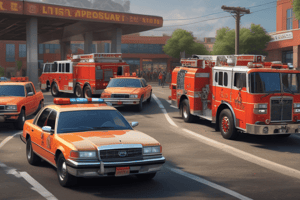Podcast
Questions and Answers
What should the first arriving unit do when responding to a traffic collision or vehicle fire?
What should the first arriving unit do when responding to a traffic collision or vehicle fire?
- Contact the Emergency Communications Center and provide information (correct)
- Perform a 360 assessment of the incident
- Determine the location of the occupants of the vehicle(s
- Establish the department accountability system
What should the Incident Commander do upon arrival at the scene of a traffic collision or vehicle fire?
What should the Incident Commander do upon arrival at the scene of a traffic collision or vehicle fire?
- Perform a 360 assessment of the incident (correct)
- Develop an initial Incident Action Plan (IAP
- Establish the department accountability system
- Determine the location of the occupants of the vehicle(s
What should the IC do to ensure the safety of vehicles at the scene of a traffic collision or vehicle fire?
What should the IC do to ensure the safety of vehicles at the scene of a traffic collision or vehicle fire?
- Check the stability of the vehicle(s
- Ensure that vehicles are in park, keys are removed, parking brakes have been set, and battery cables are cut (correct)
- Determine the location of the occupants of the vehicle(s
- Locate areas for incoming units to establish a temporary traffic control (TTC) zone
What should be established before beginning operations in the case of a vehicle fire?
What should be established before beginning operations in the case of a vehicle fire?
What should be used as an extinguishing agent for vehicle fires?
What should be used as an extinguishing agent for vehicle fires?
What should be done before releasing units from any scene where personnel were exposed to potentially harmful substances?
What should be done before releasing units from any scene where personnel were exposed to potentially harmful substances?
What should be used to locate victims at the scene of a traffic collision or vehicle fire?
What should be used to locate victims at the scene of a traffic collision or vehicle fire?
What should be used to buffer the incident area from the TTC zones and warn approaching motorists of the scene ahead?
What should be used to buffer the incident area from the TTC zones and warn approaching motorists of the scene ahead?
What should be followed for patient treatment and transport in traffic collisions with injuries?
What should be followed for patient treatment and transport in traffic collisions with injuries?
What should be done if extrication is required at the scene of a traffic collision or vehicle fire?
What should be done if extrication is required at the scene of a traffic collision or vehicle fire?
Flashcards are hidden until you start studying
Study Notes
- The document provides arrival and on-scene procedures for Chesapeake Fire Department personnel responding to motor vehicle collisions and vehicle fires and operating at roadway incidents.
- The first arriving unit should contact the Emergency Communications Center and provide information such as initial scene size-up and advise incoming units on the best route to approach the scene.
- The Incident Commander should perform a 360 assessment of the incident and establish the department accountability system for all personnel on scene.
- The IC should determine the location of the occupants of the vehicle(s) and other potential victims, check the stability of the vehicle(s), and take reasonable steps to ensure that vehicles are in park, keys are removed, parking brakes have been set, and battery cables are cut.
- The IC should locate areas for incoming units to establish a temporary traffic control (TTC) zone and develop an initial Incident Action Plan (IAP) based on available information and visible conditions.
- Resources deployed during response to a traffic collision or vehicle fire should use specific procedures for apparatus placement and personnel PPE.
- Temporary traffic control devices (TCDs) should be deployed from the rear of apparatus blocking the scene toward approaching traffic to create advanced warning and transition areas as well as to buffer the incident area from the TTC zones and warn approaching motorists of the scene ahead.
- Vehicle disabling and immobilization procedures should be followed when practicable and reasonable.
- Standard EMS protocols for patient treatment and transport should be followed in traffic collisions with injuries.
- A water supply should be established before beginning operations in the case of a vehicle fire, and personnel should approach the vehicle from the side or at an angle to avoid bumpers and other parts launched by high-pressure systems and exploding tires.
- The procedure is for traffic incident management and roadway incidents.
- Personnel should check for occupants in vehicles and commercial freight transport units.
- Referral to the Vehicle Extrication Operations Procedure is necessary if extrication is required.
- Personnel should be aware of traffic and use spotters or lookouts when possible.
- Multiple resources may be needed to protect the incident area from traffic.
- Thermal imaging cameras should be used to locate victims.
- Foam should be used as an extinguishing agent for vehicle fires.
- Primary and secondary searches should be conducted for vehicle fires and freight transport units.
- Scene preservation practices should be used to preserve evidence.
- Adequate gross decontamination should be performed before releasing units from any scene where personnel were exposed to potentially harmful substances.
Studying That Suits You
Use AI to generate personalized quizzes and flashcards to suit your learning preferences.




